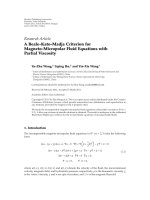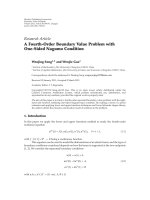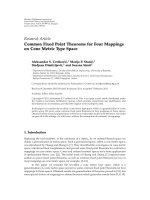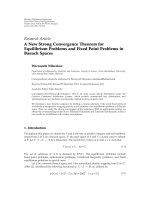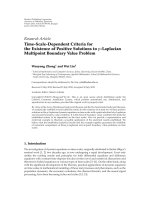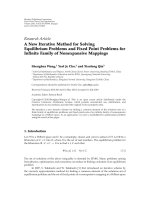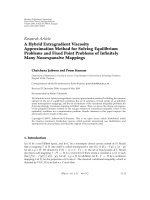Báo cáo hóa học: " Research Article A Fixed Point Approach to the Stability of a Volterra Integral Equation" pptx
Bạn đang xem bản rút gọn của tài liệu. Xem và tải ngay bản đầy đủ của tài liệu tại đây (504.48 KB, 9 trang )
Hindawi Publishing Corporation
Fixed Point Theory and Applications
Volume 2007, Article ID 57064, 9 pages
doi:10.1155/2007/57064
Research Article
A Fixed Point Approach to the Stability of a Volterra
Integral Equation
Soon-Mo Jung
Received 13 April 2007; Accepted 23 May 2007
Recommended by Jean Mawhin
We will apply the fixed point method for proving the Hyers-Ulam-Rassias stability of a
Volterra integral equation of the second kind.
Copyright © 2007 Soon-Mo Jung. This is an open access article distributed under the
Creative Commons Attribution License, which permits unrestricted use, distribution,
and reproduction in any medium, provided the original work is properly cited.
1. Introduction
In 1940, Ulam [1] gave a wi de ranging talk before the mathematics club of the University
of Wisconsin in which he discussed a number of important unsolved problems. Among
those was the question concerning the stability of group homomorphisms.
Let G
1
be a group and let G
2
be a me tric group with the metric d(·,·).Givenε>0,
does there exist a δ>0 such that if a function h : G
1
→ G
2
satisfies the inequality d(h(xy),
h(x)h(y)) <δfor all x, y
∈ G
1
, then there exists a homomorphism H : G
1
→ G
2
with d(h(x),
H(x)) <εfor all x
∈ G
1
?
The case of approximately additive functions was solved by Hyers [2] under the as-
sumption that G
1
and G
2
are Banach spaces. Indeed, he proved that each solution of the
inequality
f (x + y) − f (x) − f (y)≤ε,forallx and y, can be approximated by an exact
solution, say an additive function. In this case, the Cauchy additive functional equation,
f (x + y)
= f (x)+ f (y), is said to have the Hyers-Ulam stability.
Rassias [3] attempted to weaken the condition for the bound of the norm of the
Cauchy difference as follows:
f (x + y) − f (x) − f (y)
≤
ε
x
p
+ y
p
(1.1)
2 Fixed Point Theory and Applications
and proved the Hyers theorem. That is, Rassias proved the Hyers-Ulam-Rassias s tability
of the Cauchy additive functional equation. Since then, the stability of several functional
equations has b een extensively investigated [4–10].
The terminologies Hyers-Ulam-Rassias stability and Hyers-Ulam stability can also be
applied to the case of other functional equations, differential equations, and of various
integral equations.
For a given continuous function f and a fixed real number c, the integral equation
y(x)
=
x
c
f
τ, y(τ)
dτ (1.2)
is called a Volterra integral equation of the second kind. If for each function y(x) satisfy-
ing
y(x) −
x
c
f
τ, y(τ)
dτ
≤
ψ(x), (1.3)
where ψ(x)
≥ 0forallx, there exists a solution y
0
(x) of the Volterra integral equation
(1.2)andaconstantC>0with
y(x) − y
0
(x)
≤
Cψ(x) (1.4)
for all x,whereC is independent of y(x)andy
0
(x), then we say that the integral equation
(1.2) has the Hyers-Ulam-Rassias stability. If ψ(x) is a constant function in the above
inequalities, we say that the integral equation (1.2) has the Hyers-Ulam stability.
For a nonempty set X, we introduce the definition of the generalized metric on X.A
function d : X
× X → [0,∞] is called a generalized metric on X if and only if d satisfies
the following:
(M
1
) d(x, y) = 0ifandonlyifx = y;
(M
2
) d(x, y) = d(y, x)forallx, y ∈ X;
(M
3
) d(x, z) ≤ d(x, y)+d(y,z)forallx, y,z ∈ X.
We remark that the only one difference of the generalized metric from the usual metric is
that the range of the former is permitted to include the infinity.
We now introduce one of the fundamental results of fixed point theory. For the proof,
we refer to [11]. This theorem will play an important role in proving our main theorems.
Theorem 1.1. Let (X,d) be a generalized complete metric space. Assume that Λ : X
→ X is
a str ictly contractive operator with the Lipschitz constant L<1. If there exists a nonnegative
integer k such that d(Λ
k+1
x, Λ
k
x) < ∞ for some x ∈ X,thenthefollowingsaretrue:
(a) the sequence
{Λ
n
x} converges to a fixed point x
∗
of Λ;
(b) x
∗
is the unique fixed point of Λ in
X
∗
=
y ∈ X | d
Λ
k
x, y
< ∞
; (1.5)
(c) If y
∈ X
∗
, then
d
y,x
∗
≤
1
1 − L
d(Λy, y). (1.6)
Soon-Mo Jung 3
In this paper, we will adopt t he idea of C
˘
adariu and Radu [12] and prove the Hyers-
Ulam-Rassias stability and the Hyers-Ulam stability of the Volterra integral equation
(1.2).
2. Hyers-Ulam-Rassias stability
Recently, C
˘
adariu and Radu [12] applied the fixed point method to the investigation of
the Cauchy additive functional equation. Using such a clever idea, they could present
another proof for the Hyers-Ulam stability of that equation [13–15].
In this section, by using the idea of C
˘
adariu and Radu, we will prove the Hyers-Ulam-
Rassias stabilit y of the Volterra integral equation (1.2).
Theorem 2.1. Let K and L be positive constants with 0 <KL<1 and let I
= [a,b] be given
for fixed real numbers a, b with a<b. Assume that f : I
× C → C is a continuous function
which satisfies a Lipschitz condition
f (x, y) − f (x,z)
≤
L|y − z| (2.1)
for any x
∈ I and all y,z ∈ C. If a continuous function y : I → C satisfies
y(x) −
x
c
f
τ, y(τ)
dτ
≤
ϕ(x) (2.2)
for all x
∈ I and for some c ∈ I,whereϕ : I → (0, ∞) is a continuous function with
x
c
ϕ(τ)dτ
≤
Kϕ(x) (2.3)
for each x
∈ I, then there exists a unique continuous function y
0
: I → C such that
y
0
(x) =
x
c
f
τ, y
0
(τ)
dτ, (2.4)
y(x) − y
0
(x)
≤
1
1 − KL
ϕ(x) (2.5)
for all x
∈ I.
Proof. First, we define a set
X
=
h : I −→ C | h is continuous
(2.6)
and introduce a generalized metric on X as follows:
d(g,h)
= inf
C ∈ [0,∞] |
g(x) − h(x)
≤
Cϕ(x) ∀x ∈ I
. (2.7)
(Here, we give a proof for the triangle inequality. Assume that d(g,h) >d(g,k)+d(k, h)
wouldholdforsomeg, h,k
∈ X. Then, there should exist an x
0
∈ I with
g
x
0
−
h
x
0
>
d(g,k)+d(k,h)
ϕ
x
0
=
d(g,k)ϕ
x
0
+ d(k,h)ϕ
x
0
. (2.8)
4 Fixed Point Theory and Applications
In view of (2.7), this inequality would yield
g
x
0
−
h
x
0
>
g
x
0
−
k
x
0
+
k
x
0
−
h
x
0
, (2.9)
a contradiction.)
Our task is to show that (X,d)iscomplete.Let
{h
n
} be a Cauchy sequence in (X,d).
Then, for any ε>0 there exists an integer N
ε
> 0suchthatd(h
m
,h
n
) ≤ ε for all m,n ≥ N
ε
.
In view of (2.7), we have
∀ε>0 ∃N
ε
∈ N ∀m,n ≥ N
ε
∀x ∈ I :
h
m
(x) − h
n
(x)
≤
εϕ(x). (2.10)
If x is fixed, (2.10) implies that
{h
n
(x)} is a Cauchy sequence in C.SinceC is complete,
{h
n
(x)} converges for each x ∈ I. Thus, we can define a function h : I → C by
h(x)
= lim
n→∞
h
n
(x) . (2.11)
Since ϕ is continuous on the compact interval I, ϕ is bounded. Thus, (2.10) implies that
{h
n
} converges uniformly to h in the usual topology of C.Hence,h is continuous, that is,
h
∈ X. (It has not been proved yet that {h
n
} converges to h in (X,d).)
If we let m increase to infinity, it follows from (2.10)that
∀ε>0 ∃N
ε
∈ N ∀n ≥ N
ε
∀x ∈ I :
h(x) − h
n
(x)
≤
εϕ(x). (2.12)
By considering (2.7), we get
∀ε>0∃N
ε
∈ N ∀n ≥ N
ε
: d
h,h
n
≤
ε. (2.13)
This means that the Cauchy sequence
{h
n
} converges to h in (X,d). Hence, (X,d)iscom-
plete.
We now define an operator Λ : X
→ X by
(Λh)(x)
=
x
c
f
τ,h(τ)
dτ (2.14)
for all h
∈ X and x ∈ I. Then, according to the fundamental theorem of Calculus, Λh is
continuously differentiable on I, since f is a continuous function. Hence, we conclude
that Λh
∈ X.
We assert that Λ is strictly contractive on X.Givenanyg,h
∈ X,letC
gh
∈ [0,∞]bean
arbitrar y constant with d(g,h)
≤ C
gh
, that is,
g(x) − h(x)
≤
C
gh
ϕ(x) (2.15)
Soon-Mo Jung 5
for any x
∈ I. Then, it follows from (2.1), (2.3), (2.14), and (2.15)that
(Λg)(x) − (Λh)(x)
=
x
c
f
τ,g(τ)
−
f
τ,h(τ)
dτ
≤
x
c
f
τ,g(τ)
−
f
τ,h(τ)
dτ
≤
L
x
c
g(τ) − h(τ)
dτ
≤
LC
gh
x
c
ϕ(τ)dτ
≤
KLC
gh
ϕ(x)
(2.16)
for all x
∈ I, that is, d(Λg,Λh) ≤ KLC
gh
. Hence, we may conclude that d(Λg,Λh) ≤
KLd(g,h)foranyg,h ∈ X and we note that 0 <KL<1.
Let h
0
∈ X be given. By (2.6)and(2.14), there exists a constant 0 <C<∞ such that
Λh
0
(x) − h
0
(x)
=
x
c
f
τ,h
0
(τ)
dτ − h
0
(x)
≤
Cϕ(x) (2.17)
for every x
∈ I, since f ,h
0
are bounded on I and min
x∈I
ϕ(x) > 0. Thus, (2.7) implies that
d
Λh
0
,h
0
< ∞. (2.18)
Therefore, it follows from Theorem 1.1(a) that there exists a continuous function y
0
:
I
→ C such that Λ
n
h
0
→ y
0
in (X,d)andΛ y
0
= y
0
, or equivalently, y
0
satisfies (2.4)for
every x
∈ I.
We show that
{g ∈ X | d(h
0
,g) < ∞} = X,whereh
0
was chosen with the property
(2.18). Given any g
∈ X, since g, h
0
are bounded on I and min
x∈I
ϕ(x) > 0, there exists a
constant 0 <C
g
< ∞ such that
h
0
(x) − g(x)
≤
C
g
ϕ(x) (2.19)
for any x
∈ I.Hence,wehaved(h
0
,g) < ∞ for all g ∈ X, that is, {g ∈ X | d(h
0
,g) < ∞} =
X.Now,Theorem 1.1(b) implies that y
0
is the unique continuous function with the prop-
erty (2.4).
Finally, Theorem 1.1(c) implies that
d
y, y
0
≤
1
1 − KL
d(Λy, y)
≤
1
1 − KL
, (2.20)
since inequality (2.2) means that d(y,Λy)
≤ 1. In view of (2.7), we can conclude that the
inequality (2.5)holdsforallx
∈ I.
In the previous theorem, we have investigated the Hyers-Ulam-Rassias stability of the
Volterra integral equation (1.2) defined on compact domains. We will now prove the last
theorem for the case of unbounded domains. More precisely, Theorem 2.1 is also true if
I is replaced by an unbounded interval (
−∞,a], R,or[a,∞), as we see in the fol low ing
theorem.
6 Fixed Point Theory and Applications
Theorem 2.2. Let K and L be positive constants with 0 <KL<1 and let I denote either
(
−∞,a] or R or [a,∞) for a given real number a. Assume that f : I × C → C is a contin-
uous function which satis fies a Lipschitz condition (2.1)forallx
∈ I and all y,z ∈ C.If
acontinuousfunctiony : I
→ C satisfies inequalit y (2.2)forallx ∈ I and for some c ∈ I,
where ϕ : I
→ (0,∞) is a continuous function satisfying (2.3)foranyx ∈ I, then there exists
auniquecontinuousfunctiony
0
: I → C which satisfies (2.4)and(2.5 )forallx ∈ I.
Proof. We will prove our theorem for the case I
=
R
. We can similarly prove our theorem
for I
= (−∞,a]orI = [a,∞).
For any n
∈ N,wedefineI
n
= [c − n, c + n]. According to Theorem 2.1, there exists a
unique continuous function y
0,n
: I
n
→ C such that
y
0,n
(x) =
x
c
f
τ, y
0,n
(τ)
dτ, (2.21)
y(x) − y
0,n
(x)
≤
1
1 − KL
ϕ(x) (2.22)
for all x
∈ I
n
. The uniqueness of y
0,n
implies that if x ∈ I
n
,then
y
0,n
(x) = y
0,n+1
(x) = y
0,n+2
(x) = ···. (2.23)
For any x
∈ R, let us define n(x) ∈ N as
n(x)
= min
n ∈ N | x ∈ I
n
. (2.24)
Moreover, we define a function y
0
: R → C by
y
0
(x) = y
0,n(x)
(x), (2.25)
and we assert that y
0
is continuous. For an arbitrary x
1
∈ R, we choose the integer n
1
=
n(x
1
). Then, x
1
belongs to the interior of I
n
1
+1
and there exists an ε>0suchthaty
0
(x) =
y
0,n
1
+1
(x)forallx with x
1
− ε<x<x
1
+ ε.Sincey
0,n
1
+1
is continuous at x
1
,soisy
0
.That
is, y
0
is continuous at x
1
for any x
1
∈ R.
We will now show that y
0
satisfies (2.4)and(2.5)forallx ∈ R. For an arbitrary x ∈ R,
we choose the integer n(x). Then, it holds that x
∈ I
n(x)
and it follows from (2.21)that
y
0
(x) = y
0,n(x)
(x) =
x
c
f
τ, y
0,n(x)
(τ)
dτ =
x
c
f
τ, y
0
(τ)
dτ, (2.26)
where the last equality holds true because n(τ)
≤ n(x)foranyτ ∈ I
n(x)
and it follows from
(2.23)that
y
0
(τ) = y
0,n(τ)
(τ) = y
0,n(x)
(τ). (2.27)
Since y
0
(x) = y
0,n(x)
(x)andx ∈ I
n(x)
for all x ∈ R,(2.22) implies that
y(x) − y
0
(x)
=
y(x) − y
0,n(x)
(x)
≤
1
1 − KL
ϕ(x). (2.28)
Soon-Mo Jung 7
Finally, we assert that y
0
is unique. Assume that y
1
: R → C is another continuous
function w hich satisfies (2.4)and(2.5), with y
1
in place of y
0
,forallx ∈ R.Supposex
is an arbitrary real number. Since the restrictions y
0
|
I
n(x)
(= y
0,n(x)
)andy
1
|
I
n(x)
both satisfy
(2.4)and(2.5)forallx
∈ I
n(x)
, the uniqueness of y
0,n(x)
= y
0
|
I
n(x)
implies that
y
0
(x) = y
0
I
n(x)
(x) = y
1
I
n(x)
(x) = y
1
(x) (2.29)
as required.
Example 2.3. We int roduce some examples for I and ϕ which satisfy the condition (2.3).
Let α and ρ be constants with ρ>0andα>L.
(a) If I
= [0, ∞), then the continuous function ϕ(x) = ρe
αx
satisfies the condition
(2.3)withc
= 0, for all x ∈ I.
(b) If I
= (−∞,0], then the continuous function ϕ(x) = ρe
−αx
satisfies the condition
(2.3)withc
= 0, for any x ∈ I.
(c) If we let I
=
R
and define
ϕ(x)
=
⎧
⎨
⎩
ρe
αx
(for x ≥ 0),
ρe
−αx
(for x<0)
(2.30)
for all x
∈ R, then the continuous function ϕ satisfies the condition (2.3)with
c
= 0, for all x ∈ R.
3. Hyers-Ulam stability
In the following theorem, we prove the Hyers-Ulam stability of the Volterra integral equa-
tion (1.2) defined on any compact interval.
Theorem 3.1. Given a
∈ R and r>0,letI(a;r) denote a closed interval {x ∈ R | a − r ≤
x ≤ a + r} and let f : I(a; r) × C → C be a continuous function which satisfies a Lipschitz
condition (2.1)forallx
∈ I(a;r) and y,z ∈ C,whereL is a constant with 0 <Lr<1.Ifa
continuous function y : I(a;r)
→ C satisfies
y(x) − b −
x
a
f
τ, y(τ)
dτ
≤
θ (3.1)
for all x
∈ I(a;r) and for some θ ≥ 0,whereb is a complex number, then there exists a unique
continuous function y
0
: I(a;r) → C such that
y
0
(x) = b +
x
a
f
τ, y
0
(τ)
dτ, (3.2)
y(x) − y
0
(x)
≤
θ
1 − Lr
(3.3)
for all x
∈ I(a;r).
Proof. Let us define a set
X
=
h : I(a;r) → C | h is continuous
(3.4)
8 Fixed Point Theory and Applications
and introduce a generalized metric on X as follows:
d(g,h)
= inf
C ∈ [0,∞] |
g(x) − h(x)
≤
C ∀x ∈ I(a;r)
. (3.5)
Then, analogously to the proof of Theorem 2.1, we can show that (X,d)iscomplete.
If we define an operator Λ : X
→ X by
(Λh)(x)
= b +
x
a
f
τ,h(τ)
dτ (3.6)
for all x
∈ I(a; r), then the fundamental theorem of Calculus implies that Λh ∈ X for
every h
∈ X because Λh is continuously di fferentiable on I(a; r).
We assert that Λ is strictly contractive on X.Giveng,h
∈ X,letC
gh
∈ [0, ∞]bean
arbitrar y constant with d(g,h)
≤ C
gh
, that is,
g(x) − h(x)
≤
C
gh
(3.7)
for any x
∈ I(a;r). It then follows from (2.1)that
(Λg)(x) − (Λh)(x)
≤
x
a
f
τ,g(τ)
−
f
τ,h(τ)
dτ
≤
x
a
L
g(τ) − h(τ)
dτ
≤
LC
gh
|x − a|≤LC
gh
r
(3.8)
for all x
∈ I(a;r), that is, d(Λg,Λh) ≤ LrC
gh
.Hence,weconcludethatd(Λg,Λh) ≤
Lrd(g,h)foranyg,h ∈ X and we note that 0 <Lr<1.
Similarly as in the proof of Theorem 2.1 , we can choose an h
0
∈ X with d(Λh
0
,h
0
) <
∞.Hence,itfollowsfromTheorem 1.1(a) that there exists a continuous function y
0
:
I(a;r)
→ C such that Λ
n
h
0
→ y
0
in (X,d)asn →∞, and such that y
0
satisfies the Volterra
integral equation (3.2)foranyx
∈ I(a;r).
By applying a similar argument of the proof of Theorem 2.1 to this case, we can show
that
{g ∈ X | d(h
0
,g) < ∞} = X. Therefore, Theorem 1.1(b) implies that y
0
is a unique
continuous function with the property (3.2). Furthermore, Theorem 1.1(c) implies that
y(x) − y
0
(x)
≤
θ
1 − Lr
(3.9)
for all x
∈ I(a;r).
Unfortunately, we could not prove the Hyers-Ulam stability of the integral equation
defined on an infinite interval. So, it is an open problem whether the Volterra integral
equation (1.2) has the Hyers-Ulam stability for the case of infinite intervals.
References
[1] S.M.Ulam,A Collection of Mathematical Problems, Interscience Tracts in Pure and Applied
Mathematics, no. 8, Interscience, New York, NY, USA, 1960.
[2] D. H. Hyers, “On the stability of the linear functional equation,” Proceedings of the National
Academy of Sciences of the United States of America, vol. 27, no. 4, pp. 222–224, 1941.
Soon-Mo Jung 9
[3] Th. M. Rassias, “On the stability of the linear mapping in Banach spaces,” Proceedings of the
American Mathematical Soc iety, vol. 72, no. 2, pp. 297–300, 1978.
[4] G. L. Forti, “Hyers-Ulam stability of functional equations in several variables,” Aequationes
Mathematicae, vol. 50, no. 1-2, pp. 143–190, 1995.
[5] P. G
˘
avrut¸a, “A generalization of the Hyers-Ulam-Rassias stability of approximately additive
mappings,” Journal of Mathematical Analysis and Applications, vol. 184, no. 3, pp. 431–436,
1994.
[6] D. H. Hyers, G. Isac, and Th. M. Rassias, Stability of Functional Equations in Several Variables,
vol. 34 of Progress in Nonlinear Differential Equations and Their Applications,Birkh
¨
auser, Boston,
Mass, USA, 1998.
[7] D. H. Hyers and Th. M. Rassias, “Approximate homomorphisms,” Aequationes Mathematicae,
vol. 44, no. 2-3, pp. 125–153, 1992.
[8] S M. Jung, “Hyers-Ulam-Rassias stability of functional equations,” Dynamic Systems and Ap-
plications, vol. 6, no. 4, pp. 541–565, 1997.
[9] S M. Jung, Hyers-Ulam-Rassias Stability of Functional Equations in Mathematical Analysis,
Hadronic Press, Palm Harbor, Fla, USA, 2001.
[10] Th. M. Rassias, “On the stability of functional equations and a problem of Ulam,” Acta Appli-
candae Mathematicae, vol. 62, no. 1, pp. 23–130, 2000.
[11] J. B. Diaz and B. Margolis, “A fixed point theorem of the alternative, for contractions on a gen-
eralized complete metric space,” Bulletin of the American Mathematical Society, vol. 74, pp. 305–
309, 1968.
[12] L. C
˘
adariu and V. Radu, “On the stability of the Cauchy functional equation: a fixed point ap-
proach,” in Iteration Theory (ECIT ’02), vol. 346 of Grazer Math. Ber., pp. 43–52, Karl-Franzens-
Univ. Graz, Graz, Austria, 2004.
[13] L. C
˘
adariu and V. Radu, “Fixed points and the stability of Jensen’s functional equation,” Journal
of Inequalities in Pure and Applied Mathematics, vol. 4, no. 1, article 4, pp. 1–7, 2003.
[14] S M. Jung, “A fixed point approach to the stability of isometries,” Journal of Mathematical Anal-
ysis and Applications, vol. 329, no. 2, pp. 879–890, 2007.
[15] V. Radu, “The fixed point alternative and the stability of functional equations,” Fixed Point The-
ory, vol. 4, no. 1, pp. 91–96, 2003.
Soon-Mo Jung: Mathematics Section, College of Science and Technology, Hong-Ik University,
Chochiwon 339-701, South Korea
Email address:
